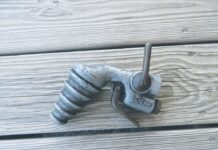Do you ever stop to think about how many times you use water before you walk out the door to start your day? We wake up in the morning, use the restroom, take a shower, brush our teeth, grab a cup of coffee and head out for the day.
Water is an important part of our daily lives and we use it for a wide variety of purposes, but do we really understand how much we use? Water usage estimates vary from 70 to 100 gallons per day, per person.
Think about that
You would use 14, five-gallon buckets of water on the low end and 20 buckets on the high end; or 70-one gallon jugs (like we buy milk in) or 100 jugs. Either way, it seems like a lot of water! But if you leave the water running while you brush your teeth, put a container under the faucet to see how much water goes down the drain. It will surprise you.
Natural resources
Water is one of our greatest resources with 75 percent of the earth being covered by water. But only one percent of this water is fresh, usable water found in either surface or ground water.
Surface water is found in lakes, rivers and streams. Ground water is fresh water that filters downward through the soil, gravel and cracks in the rocks to collect in aquifers beneath the earth’s surface.
Geologic formation
An aquifer is a geologic formation containing water in quantities sufficient to yield water to a well. The water in your home either comes from a well on your property or a public water source.
We all take for granted that we will have water when we turn on the faucet. There is a finite amount of water on earth.
Water cycle
The water on earth is used over and over again. Earth’s water is always in movement, and the natural water cycle, also known as the hydrologic cycle, describes the continuous movement of water on, above, and below the surface of the Earth. Water is always changing states between liquid, vapor and ice, with these processes happening in the blink of an eye and over millions of years.
Renewable resources
It is important for us to understand that water is not a renewable resource. That means the water we use today is the same water that was here when dinosaurs roamed the land. Everyone relies on water and other natural resources to exist. What we do on the land impacts the quality and quantity of water and other natural resources.
Water conservation
Conserving or using our water wisely is an effective and efficient way to sustain our water supply and protect our environmental health. Conserving or using our water wisely is an effective and efficient way to sustain our water supply and protect our environmental health.
While most of us east of the Mississippi River believe our water supply is plentiful, ask anyone in the west about water rights and you get a whole different picture. Many areas have experienced significantly reduced water levels due to human demand outpacing natural availability.
Water rights
A 2014 USGS study believes that nearly all of the U.S. will experience freshwater shortages sometime within the next decade. So back to my question about water use, let’s think about some common sense, easy to adopt practices that could result in real water conservation.
Indoors, three-fourths of all water is used in the bathroom.
The bathroom
In the average home, the toilet accounts for 28 percent of water use. Standard toilets use 1.6 gallons per flush, while older toilets can use as much as three and half to seven gallons per flush. If you have an older toilet place bricks or a milk jug filled with sand in the tank. This will take up space and you won’t use as much water.
You can also turn off the faucet while brushing your teeth or shaving; that alone can save a person more than 200 gallons per month.
Five minutes
Time your shower and keep it under five minutes; you will save to 1,000 gallons per month.
Cut back
Other ideas to conserve water include:
- Use the garbage disposal sparingly (or not at all). Instead, compost vegetable and food waste to save gallons each time.
- High-efficiency washing machines can conserve large amounts of water. Traditional models use between 27 and 54 gallons of water per load, but new, energy and water-conserving models (front-loading or top-loading, non-agitator ones) use less than 27 gallons per load.
- Use your dishwasher and clothes washer for only full loads.
- When washing the dishes by hand, don’t leave the water running for rinsing. If you have a double basin, fill one with soapy water and one with rinse water.
- Not rinsing dishes prior to loading the dishwasher could save up to 10 gallons per load.
- Keeping a pitcher of water in the refrigerator saves time and water instead of running the tap until it gets cold. This seems like a no-brainer to me since we have done this since I was a child!
I have a quote above my desk that says, “Success is the sum of small efforts repeated day in and day out.” Working together, we can use our water resources wisely to make sure future generations have an adequate water supply.
Contact your local soil and water conservation district for more ideas to conserve your local resources.













